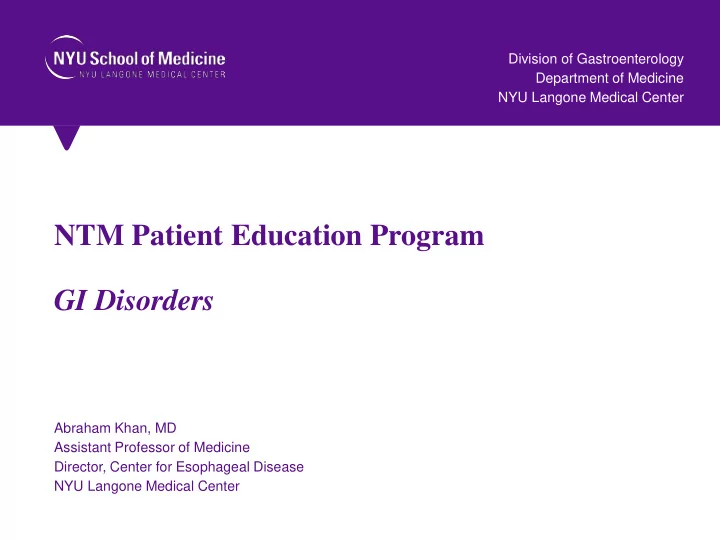

Division of Gastroenterology Department of Medicine NYU Langone Medical Center NTM Patient Education Program GI Disorders Abraham Khan, MD Assistant Professor of Medicine Director, Center for Esophageal Disease NYU Langone Medical Center
Outline • Importance of overall nutrition • Could your NTM be associated with a GI condition? • Potential relationship with esophageal disorders 2
Nutrition • Role of nutrition in NTM: important and part of treatment plan • Balanced diet • Maintaining healthy weight • Reasons for weight loss • Response of body to NTM and increased calorie needs • Nausea, medication side effects, and decreased appetite • Body mass index (BMI) • Underweight: BMI < 18.5: focus on weight gain • Normal weight: BMI 18.5-24.9 • Overweight: BMI 25-29.9 Obese: BMI ≥ 30 • 3
Nutrition Tips • If appetite is poor: ask your doctor for help • First assess underlying cause: depression, nausea, pain, and dry mouth • Ask about medications to improve ability to avoid symptoms during meals • Consider an appetite stimulant • More calories • Small and frequent meals • Oral supplements • *Meet with a registered dietician for help* • Calorie counting and goals • Advice on specific meals 4
NTM and Esophageal Disorders • First…how could they be related? 5
The Basics • The Esophagus • Tubular structure · Major purpose: transport swallowed food from throat to stomach • Length: 18 to 22 cm on average 6
Swallowing 7
Esophageal Disease • Gastroesophageal Reflux Disease (GERD) • Definition: a condition that develops when the reflux of stomach contents causes troublesome symptoms and/or complications Gastroesophageal reflux Symptoms Damage 8
Symptoms • Typical symptoms • Postprandial heartburn • Effortless regurgitation • Atypical symptoms • Potentially due to GERD • Includes trouble swallowing, chest pain, cough, hoarseness, excessive throat clearing, wheezing, feeling of a lump in the throat • Silent GERD 9
Potential Complications 10
Esophageal Swallowing Disorders • An esophageal motility (neuromuscular) disorder: problem with pushing food and/or liquid through esophagus into stomach • Examples · Esophageal spasm, achalasia • Can result in swallowed contents ascending up into airway • Mild: may not have trouble swallowing • Severe: significant trouble swallowing, risk of large amounts of fluid coming “back up” and into airway 11
Current Knowledge • 2007 study of 58 patients with NTM 1 • 26% had GERD by pH study and of these only 27% had typical symptoms of GERD • The GERD patients had worse bronchiectasis and lung inflammation on imaging • 2011 review on bronchiectasis and GERD 2 • Included many patients with NTM • Large amount of patients (studies 26% to 75%) with bronchiectasis have symptomatic or ‘silent’ GERD • GERD may influence severity of bronchiectasis • *Cause and effect has not been established* 1 Koh et al. Chest 2007 12 2 Lee et al. Pulm Med 2011
Current Knowledge • Treatment of GERD may also have consequences • Many patients are on proton pump inhibitors (PPIs) to decrease the acidity of the stomach Schoenfeld et al. JAMA Intern Med. 2016; 176: 172-174 13
Questions Needing Answers • Does GERD predispose a patient to develop NTM? • Can GERD make NTM worse? • Can treating GERD with PPIs make NTM worse? • If GERD is involved, is the problem from acid, bile, or any type of reflux? • How should we treat GERD in patients with NTM? • Could an esophageal motility or swallowing problem complicate the picture? 14
Procedures to Help • Upper endoscopy • Procedure through mouth with anesthesia • Good for looking at lining of esophagus and excluding complications in the esophagus from GERD • Cannot disprove GERD • Minimally useful for motility of the esophagus 15
Acid Reflux Procedure • pH study #1: wireless pH capsule • Small capsule placed on endoscopy • Transmits acid data to recorder for 48-96 hours • Capsule falls off on own and does not need another procedure to retrieve • Recorder returned by patient when recording stopped 16
Other Reflux Procedure • pH study #2: pH-impedance testing • Catheter through nose and into stomach, attached to a recorder worn by patient • Records acid, bile and all reflux for 24 hours • Recorder returned the next day by patient and data is then downloaded 17
Swallowing Procedure • Esophageal manometry • Deciphers if there is a motility problem in esophagus • Catheter placed through the nose and attached to computer on the outside of body • Study takes 5 to 10 minutes, about 10 swallows of liquid needed • Catheter is then removed and data is interpreted by physician 18
Current Goal • Until more research is developed to answer the aforementioned questions… • Utilize specialty esophageal testing to identify and appropriately treat esophageal disorders in our patients with NTM 19
Thank You Contact Information: Abraham Khan, M.D. Office: 212-263-3095 20
Recommend
More recommend